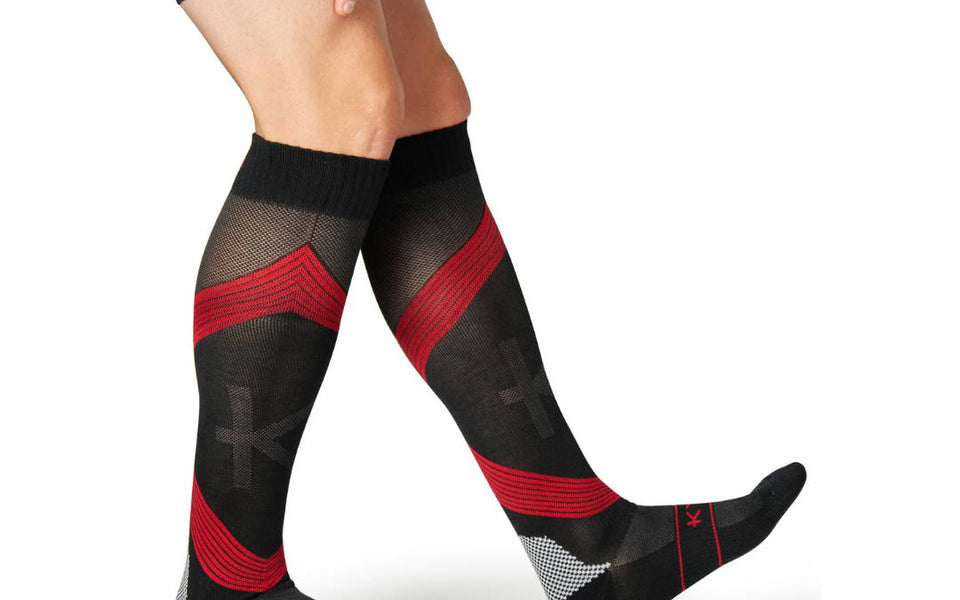KYMIRA® Sport Infrared Compression Socks - Black & Red
In almost all sports, healthy feet are integral to peak performance, but they're mostly forgotten about. Until there's a problem, they're ignored.
The human foot is a remarkable structure. Consisting of 26 bones, 30 joints and more than 100 muscles, tendons and ligaments, the foot provides movement, balance, stability, support, force generation and shock absorption. It does this all day, every day without compromise.
In this article we're going to look at the foot, how and why you should care for it and what you can do to maintain healthy and functional feet. We won't give medical advice, but we'll look at the scientific research around what the foot does and how best to ensure your feet stay strong, functional and healthy.
Time to read: 3 minutes
Beginner
Key Points:
- Footwear overview
- Why focusing in foot and ankle strength
- Using compression socks as a support
Consisting of 26 bones, 30 joints and more than 100 muscles, tendons and ligaments, the foot provides movement, balance, stability, support, force generation and shock absorption all day, every day without compromise.
Feet, force and function – an overview
Let's make one thing clear – as an active person, your feet take an absolute beating. When you factor in the loads that pass through the foot – up to 3 times your body weight during running [1], you can only then to begin to imagine what a truly remarkable job your feet do for you.
Not only are they able to deal with large forces, but the way also they deal with these forces is interesting, utilising the whole foot to distribute and impact load. For example, in running the heel takes most of the loading. In jumping however, the big toe is responsible for the work [2]. In practice, this means that you must look after the entire foot if you want to maintain peak foot health and function.
Footwear plays a large role in maintaining the integrity of the foot throughout sporting movements as well. The forces your feet are exposed to vary depending on the activity - running in a straight-line places different demands on your feet relative to team sports or jumping – but ensuring you are wearing suitable footwear for your chose activity and gait are essential.
We know from research that different types of footwear are optimised for particular sports and gaits [3], so it's worth having your foot striking and posture analysed before you make a buying decision.
Training the foot for strength and stability
Instability in the feet is a leading cause of injury in the lower leg (foot and ankle in particular). In a 2017 study across 37 sports, 27% of all the injuries were to the foot and ankle [4]. This data alone shows us how frequent the incidence of injury to this area is.
If we refer to the opening lines of this article, I stated that there are over 100 muscles that move the foot. Logically therefore, the feet will respond to strength training and structural support to maintain full function and prevent injuries. There's strong research that suggests this hypothesis is true.
In a 2020 study, 118 runners were separated into two groups – one group ran as normal, whereas the other group were given an 8-week training programme focussing on foot and ankle strength. The results were clear, because the group who specifically strengthened the foot suffered a 2.42-fold lower rate of running related foot injury [5].
Common methods of strengthening the feet is with bare foot walking, exercises on unstable surfaces, skipping and weight training in bare feet. All of these remove the protection and padding of shoes, forcing the muscles to engage more and work extra hard.
Using compression socks to aid foot stability
One of the ways we can avoid foot injuries is by increasing the compression forces that stabilise the foot. Research shows that one of the best ways to do this is with compression socks – even anecdotally, runners have reported that they both help prevent injuries and reduce the symptoms of existing injuries [6].
The KYMIRA® compression sock combines both the structural support and stability of compression with the performance enhancing capabilities of infrared technology. By wearing the socks you'll benefit from increased blood flow into the feet, helping with the tissue elasticity for the connective tissues. You'll also benefit from increased tissue oxygenation and improved energy efficiency.
Collectively, these improve foot health, strength and stability and the net result is better athletic performance and reduced injury risk.
Looking after your feet – final thoughts
As the unsung heroes of the physiology of movement, feet are often overlooked. They rarely (if ever) receive the special treatment of other body parts, despite being easily as important as anything else. What this blog post has shown is that athletically, there are very justifiable reasons that you should take care of your feet – you'll improve your athletic ability, reduce your injury risk and enjoy your training and competition more.
References
[1] http://barefootrunning.fas.harvard.edu/4BiomechanicsofFootStrike.html
[2] https://www.hindawi.com/journals/jme/2017/3432074/
[3] https://www.ncbi.nlm.nih.gov/pmc/articles/PMC7039038/
[4] https://pubmed.ncbi.nlm.nih.gov/27802962/
[5] https://pubmed.ncbi.nlm.nih.gov/33156692/
